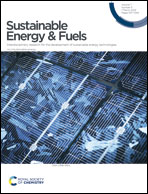Better through oxygen functionality? The benzophenone/dicyclohexylmethanol LOHC-system†
Abstract
Storage in liquid organic hydrogen carriers (LOHCs) constitutes a safe and infrastructure-compatible way to transport and handle hydrogen. To date, widely studied LOHC-systems are often differentiated into nitrogen-containing systems, such as N-ethylcarbazole (H0-NEC)/perhydro-N-ethylcarbazole (H12-NEC), or heteroatom-free LOHC systems, such as toluene/methylcyclohexane, benzyltoluene (H0-BT)/perhydro-benzyltoluene (H12-BT) and dibenzyltoluene (H0-DBT)/perhydro-dibenzyltoluene (H18-DBT). In this contribution we introduce the oxygen-containing LOHC system benzophenone/dicyclohexylmethanol, a system that is characterized by an excellent hydrogen storage capacity of 7.19 mass% or 2252 W h L−1. We herein demonstrate that benzophenone (H0-BP) can be selectively and completely hydrogenated to dicyclohexylmethanol (H14-BP, perhydro-benzophenone) over Ru/Al2O3 catalysts at 50 bar hydrogen pressure and temperatures in the range of 90 to 180 °C. Hydrogen can be released from H14-BP using Pt-based catalysts to form H0-BP at temperatures of 250 °C. Depending on the catalyst support, undesired dehydration to diphenylmethane may become relevant with acidic supports favoring dehydrative water removal from the molecule. Most remarkably, Cu-based catalysts, such as the well-known commercial methanol synthesis catalyst, show excellent activity in the selective transformation of H14-BP to dicyclohexylketone (H12-BP) at surprisingly mild conditions. This enables hydrogen release of 1/7 of the stored hydrogen at temperatures as low as 170 °C.

- This article is part of the themed collection: Sustainable Energy & Fuels Recent HOT Articles


 Please wait while we load your content...
Please wait while we load your content...